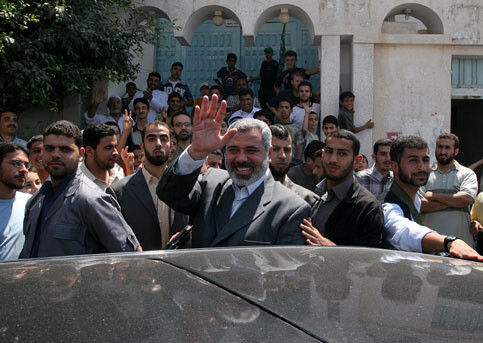The Electronic Intifada 15 July 2006

Fair game, according to the NY Times: Palestinian Prime Minister Ismail Haniyeh from Hamas waves to his supporters after Friday prayers in front of a Gaza City mosque, 14 July 2006. (MaanImages/Wesam Saleh)
In an editorial this Saturday, The New York Times clearly crossed the line from its already biased reporting in support of Israel, to cheerleading for Israel, and even advocating that Israel conduct illegal, extrajudicial executions of Arab political leaders. Positions taken by the Times matter because it is the US’ most influential newspaper. The Times both reflects and helps to shape US policy and public opinion.
The previous two days, the editorial and news departments at the Times had stated clear support for Israel’s assaults on Gaza and Lebanon. In doing so, the Times has again fallen in line with Israeli and US government positions. The Times has completely whitewashed recent Israeli violence, erased history and placed all blame on Palestinians, Arabs and Muslims for the current fighting. In the Times, as in much of the US corporate media, the Palestinian narrative has been completely overwhelmed by Israeli positions and international law has been cast aside.
Because the New York Times’ reporters in Israel/Palestine have reported on many examples of Israel’s disproportionate violence over the last months, it is all the more astonishing that these realities have now been completely erased by the Times. One is left to wonder whether the Times’ selective representation of history is a political or psychological phenomenon, or perhaps a combination of both. In addition to reflecting conscious and unconscious biases, and a blatant political agenda, it seems likely that it’s a product of the same disastrous tendency during a crisis to “rally around the flag”, suppress dissenting views and blame “the other” that we experienced after 9/11 and during the Iraq War.
In a clear statement of support for assassination, The New York Times 15 July editorial “Playing Hamas’ Game” advised Israel “to focus its fire much more directly at the leaders and fighters of these two groups [Hamas and Hezbollah]”.[1] Most human rights organizations, including Amnesty International, condemn extrajudicial execution as a violation of international law because it is conducted “without offering proof of guilt or right of defence.”[2] Amnesty International has repeatedly called on Israel to instead employ “alternative lawful means” [3] like arrest and prosecution. Amnesty also notes that Israel’s executions “have resulted in the unlawful killing of scores and injury of hundreds of bystanders, including children.”[4] Apparently, none of this matters to the Times.
On top of the illegality of Israel’s extrajudicial executions, they seem to be backfiring. Israel has executed hundreds Palestinians, including Hamas leaders Sheikh Yassin and Abdelaziz Rantissi, but Palestinian resistance continues unabated, and Hamas is now more popular than ever.
On 15 July, as in a 13 July editorial,[5] the Times’ editors again asserted that Hamas and Hezbollah are clearly and solely responsible for the latest violence through the capture of three Israeli soldiers. The Times went on to counsel Israel to “do far more to minimize the damage to civilian bystanders” because “Most Arabs are not blaming Hamas and Hezbollah for provoking these Israeli raids. They are blaming Israel for carrying them out … That is not fair. But it is the way things work in the real world.”
In blaming only Arabs and consoling Israel about the lack of fairness in the “real world”, the Times displays complete blindness to Israeli provocations. Ironically, The Times’ recent editorials have barely hinted at the scale of Israeli violations, though much of the following Israeli
violence can be found in past New York Times news articles:
In blaming only Arabs and consoling Israel about the lack of fairness in the “real world”, the Times displays complete blindness to Israeli provocations.
Ironically, The Times’ recent editorials have barely hinted at the scale of Israeli violations, though much of the following Israeli violence can be found in past New York Times news articles

Omitting history: A 14 July graphic from the New York Times online edition
In a one-sided 14 July column, “The Kidnapping of Democracy”, Times pundit Thomas Friedman blames Hamas, Hezbollah, Syria and Iran for subverting “Arab Democracy”, while failing to note a single criticism of Israel or the US. He relies on quotes from Israeli political theorist Yaron Ezrahi to support his thesis. Friedman explains, “The world needs to understand what is going on here: the little flowers of democracy that were planted in Lebanon, Iraq and the Palestinian territories are being crushed by the boots of Syrian-backed Islamist militias who are desperate to keep real democracy from taking hold in this region and Iranian-backed Islamist militias desperate to keep modernism from taking hold … It may be the skeptics are right: maybe democracy, while it is the most powerful form of legitimate government, simply can’t be implemented everywhere.”
In a stunning display of dishonesty, after ranting about Arab efforts to crush democracy, Friedman completely leaves out the Israeli and US efforts to subvert and overthrow the democratically elected Hamas-led Palestinian Authority. For example, on June 29, Israel arrested over 60 Palestinian cabinet ministers, elected members of the Palestinian parliament and other Palestinian leaders with ties to Hamas (another major fact missing from the New York Times 14 July map and graphic). With the failure of the Friedman-supported US war in Iraq, it should also be obvious to Friedman that Israel, the US and their allies cannot “bring democracy to the Middle East” through war and occupation. Contrary to Friedman’s assertion, democracy can take root amongst any people, but democracy cannot be imposed through violence.
Unfortunately, as the 14 July map illustrated, the Times news reporters in Israel/Palestine are now writing as if history began and ended with the election of Hamas and the June 25 capture of an Israel soldier. In a “News Analysis” article entitled “Sign That Crisis is Regional, Not Just Israel vs. Palestinians”,[6] The New York Times’ Jerusalem Bureau Chief Steven Erlanger revives a favorite US thesis, that Islam is the real problem in the current crisis. In his analysis, Erlanger relies on quotes from former Israeli Ambassador Itamar Rabinovich and right-wing Israeli academic Gerald Steinberg.
Erlanger writes that for Israel, the issue is “is the broader problem of radical Islam - of Hamas, as a part of the regional Muslim Brotherhood, and of Iran, a serious regional power with considerable influence on Syria, Hezbollah, Islamic Jihad and the military wing of Hamas.” But Erlanger himself has recently reported many facts that show that violent and aggressive Israeli government policies are at least as much “the problem” as “radical Islam.”
Erlanger omits the much-reported realities that Israeli repression helped bring Hamas to power, that Israel’s invasion of Lebanon in 1982 led to the creation of Hezbollah, and that the US/Israeli assault on Hamas and the West’s cut in aid and relations has driven Hamas closer to Hezbollah and Iran.
Erlanger inaccurately claims that “Israel and the United States still hope that Hamas will respond to the responsibilities of elected leadership and moderate its rejection of Israel to bring a better life to its people”. But rather than coaxing change, Israel and the US have clearly opted to overthrow the Hamas-led Palestinian Authority through cuts in aid funding and relations, military attacks, siege, and the arrests of leaders.
Erlanger makes the dubious assertions that only the Palestinian capture of an Israeli soldier on June 25 spoiled the chances of a promising “new relationship” between Israeli and Palestinian leaders Ehud Olmert and Mahmoud Abbas, and scuttled chances for “the renewal of negotiations with Israel” based on agreement between Hamas and Fateh on “The Prisoners’ Document.”[7] But Israeli leaders had repeatedly called “The Prisoners’ Document” irrelevant as Erlanger himself reported, and Israel has refused substantive negotiations with Palestinians for years.
Today’s New York Times’ endorsement of extrajudicial execution is a final wake up call indicating that a major US institution has completely lost its way. With Israelis feeling under attack, any remaining sense of objectivity on the part of The New York Times, and many other US institutions has simply disappeared. Israel asserts that its three captured soldiers matter more than the lives of millions of Arabs, and then acts to impose that assertion. US politicians, reporters and editors have fallen into line, and the Israeli narrative has taken over. Arab and Palestinian lives are given no value, and their narratives have largely disappeared from the media. Professional journalistic standards of balance, and any commitment to the norms of international law have completely collapsed.
As occurred with Iraq, one can only hope that with time and continuing pressure from the public, the Times’ blind support for Israel will recede somewhat, and some of the realities about Israeli government behavior that are now being covered up will be exposed.
Write to the New York Times
All Comments:
Comments on Steven Erlanger’s article and Maps with Graphics
Comments on Editorials and Thomas Friedman’s column
Letters intended for publication should be no more than 150 words.
Related Links





